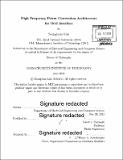High frequency power conversion architecture for grid interface
Author(s)
Lim, Seungbum
DownloadFull printable version (18.98Mb)
Other Contributors
Massachusetts Institute of Technology. Department of Electrical Engineering and Computer Science.
Advisor
David J. Perreault.
Terms of use
Metadata
Show full item recordAbstract
With the present ac-voltage distribution system, ac-dc converters are key components for driving many dc voltage applications from the ac grid voltage. There are a lot of electronic devices that natively operate from the dc voltage including light emitting diodes (LEDs), personal and laptop computers, and smart phones; for all of them there is a drive to increase functionality and to reduce the volume at the same time. The desire for further miniaturization is, however, facing a dominant obstacle strained by the performance requirements on power electronic circuits. In this thesis, a design technique for high-performance ac-dc power converters will be presented. A new grid interface ac-dc conversion architecture and associated circuit implementations are proposed along with novel control methods. This approach simultaneously address design challenges associated with high performance (e.g., high efficiency, high power factor, miniaturization, and high reliability/lifetime) of ac-dc power conversion systems. The proposed architecture is suitable for realizing ac-dc converters that switch in the HF range (3-30 MHz) with relatively low-voltage components and with zero-voltage switching (ZVS) conditions, enabling significant converter size reduction while maintaining high efficiency. Moreover, the proposed approach can achieve reasonably high power factor about 0.9, while dynamically buffering twice-line frequency energy using small capacitors operating with large voltage swings over the ac line voltage cycle. The ac-dc converter design shows that excellent combinations of power density, efficiency, and power factor can be realized with this approach.
Description
Thesis: Ph. D., Massachusetts Institute of Technology, Department of Electrical Engineering and Computer Science, 2016. Cataloged from PDF version of thesis. Includes bibliographical references (pages 145-151).
Date issued
2016Department
Massachusetts Institute of Technology. Department of Electrical Engineering and Computer SciencePublisher
Massachusetts Institute of Technology
Keywords
Electrical Engineering and Computer Science.